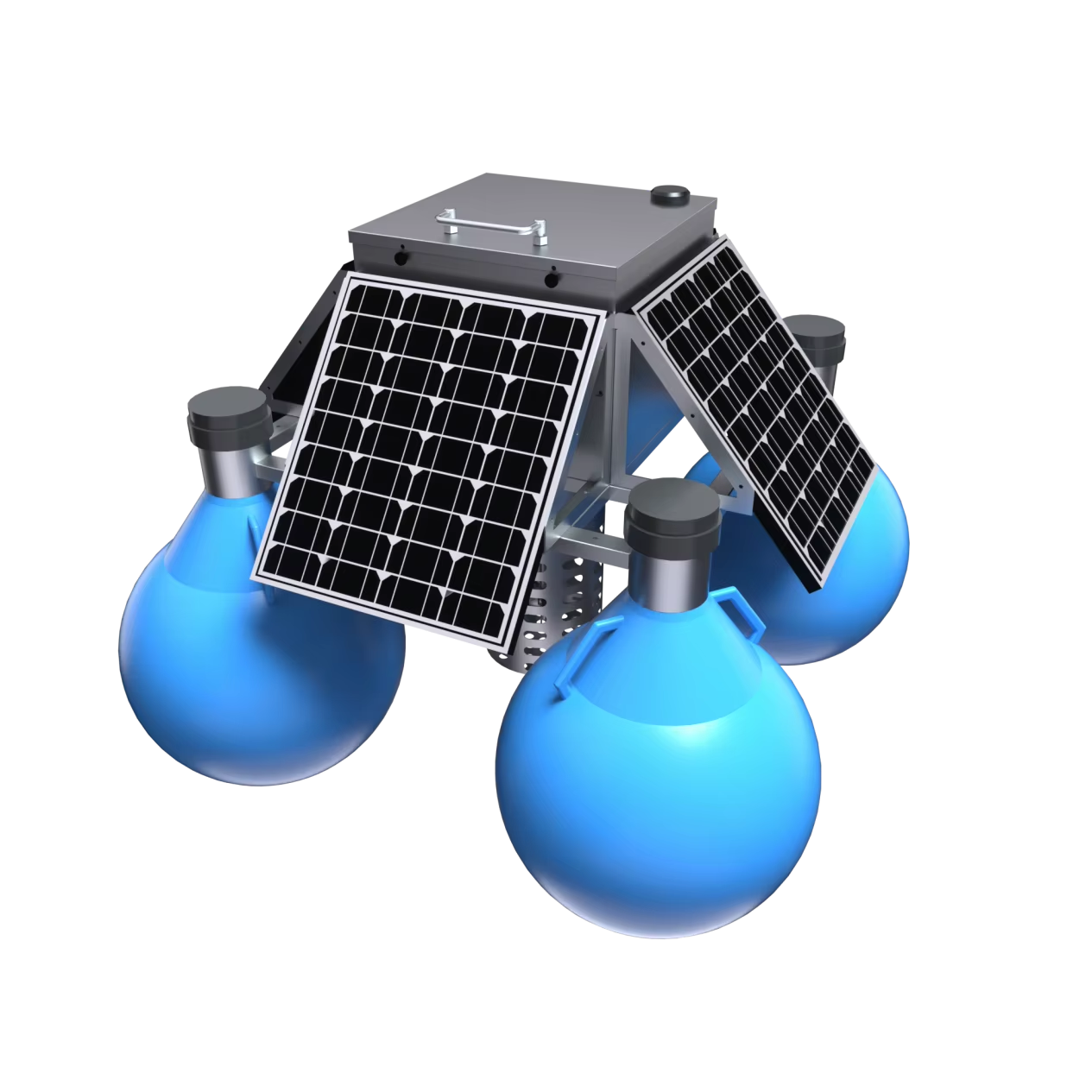Sa bag-ohay nga mga tuig, ang pag-uswag sa mga bag-ong teknolohiya nagbag-o sa pagdumala sa kalidad sa tubig, uban ang pagpaila sa usa ka intelihente nga buoy system nga naghiusa sa pag-monitor ug paglimpyo sa mga gimbuhaton. Kining bag-o nga sistema gitakda sa pagbag-o sa paagi sa atong pagdumala ug pagmentinar sa kalidad sa tubig sa mga lanaw, suba, ug uban pang mga palibot sa tubig. Ania ang pipila ka hinungdanon nga mga highlight sa kini nga pag-uswag:
1.Komprehensibo nga Pag-monitor sa Kalidad sa Tubig
- Tinuod nga Panahon nga Pagkolekta sa Datos: Ang intelihenteng buoy nasangkapan sa mga advanced sensors nga padayon nga nagmonitor sa nagkalain-laing mga parameter sa kalidad sa tubig, lakip ang pH level, temperatura, dissolved oxygen, turbidity, ug nutrient nga lebel. Kini nga real-time nga pagkolekta sa datos nagtugot alang sa diha-diha nga pagsusi sa mga kondisyon sa tubig.
- Pagpasa sa Data: Ang buoy nagpadala sa nakolektang datos ngadto sa sentral nga sistema sa pagdumala, nga makapahimo sa mga stakeholders nga maka-access sa kasamtangang impormasyon sa kalidad sa tubig gikan sa bisan asa. Kini nga bahin nagpalambo sa abilidad sa pagtubag dayon sa bisan unsang dili maayo nga mga pagbag-o sa kalidad sa tubig.
2.Awtomatikong Paglimpyo nga Kalihokan
- Nahiusa nga Mekanismo sa Paglimpyo: Kini nga sistema labaw pa sa pag-monitor pinaagi sa pag-apil sa mga kapabilidad sa awtomatikong pagpanglimpyo. Kung ang datos sa kalidad sa tubig nagpaila sa kontaminasyon o sobra nga mga basura, ang buoy mahimong ma-aktibo ang mekanismo sa paglimpyo, nga mahimo’g maglakip sa pag-deploy sa mga drone sa ilawom sa tubig o uban pang mga aparato sa paglimpyo aron matubag ang isyu.
- Mga Operasyon nga Nagpadayon sa Kaugalingon: Ang buoy makaandar nga awtonomiya, nanginahanglan gamay nga interbensyon sa tawo. Uban sa mga solar panel o uban pang nabag-o nga gigikanan sa enerhiya, ang sistema makapadayon sa padayon nga paglihok sa lainlaing mga kahimtang sa kalikopan.
3.Gipauswag nga Paghimog Desisyon
- Pag-analisa sa datos: Ang intelihenteng buoy system naggamit sa data analytics ug machine learning algorithms aron mailhan ang mga pattern ug matagna ang posibleng mga isyu sa kalidad sa tubig. Kini nga proactive nga pamaagi makahimo sa mas maayo nga mga desisyon sa pagdumala ug mas epektibo nga alokasyon sa kapanguhaan.
- User-Friendly nga Interface: Ang sentral nga sistema sa pagdumala adunay usa ka user-friendly nga interface nga nagtugot sa mga operator nga dali nga mahanduraw ang datos, magtakda og mga alerto alang sa piho nga mga sukaranan sa kalidad sa tubig, ug pagmonitor sa kahimtang sa mga operasyon sa paglimpyo.
4.Epekto sa Kalikopan
- Malungtarong mga Praktis: Pinaagi sa pag-automate sa pagdumala sa kalidad sa tubig, ang intelihente nga buoy system nagpasiugda sa malungtarong mga gawi sa pagdumala sa kalikupan sa tubig. Nakatabang kini nga dali nga mailhan ug maminusan ang mga gigikanan sa polusyon, sa ingon mapanalipdan ang mga ekosistema ug biodiversity.
- Episyente sa Gasto: Ang pag-automate sa mga proseso sa pag-monitor ug pagpanglimpyo makapakunhod sa panginahanglan alang sa manual labor ug makapamenos sa gasto sa operasyon sa kadugayan, nga naghimo niini nga mas ekonomikanhon nga solusyon alang sa mga munisipyo ug mga ahensya sa kinaiyahan.
5.Panapos
Ang pagpaila sa bag-ong sistema sa intelihente nga buoy nagtimaan sa usa ka hinungdanon nga pag-uswag sa pagdumala sa kalidad sa tubig. Pinaagi sa paghiusa sa mga pag-andar sa pag-monitor ug paglimpyo, kini nga teknolohiya dili lamang nagpauswag sa kaepektibo sa pagsusi ug pagdumala sa kalidad sa tubig apan gipauswag usab ang katakus sa pagpadayon sa himsog nga mga palibot sa tubig. Kini nga bag-ong solusyon nagrepresentar sa usa ka lakang sa unahan sa pagkab-ot sa awtomatiko ug malungtaron nga pagdumala sa among bililhon nga mga kahinguhaan sa tubig.
Makahatag usab kami usa ka lainlaing mga solusyon alang sa
1. Handheld meter para sa multi-parameter nga kalidad sa tubig
2. Floating Buoy system para sa multi-parameter nga kalidad sa tubig
3. Awtomatikong panglimpyo nga brush alang sa multi-parameter water sensor
4. Kompleto nga set sa mga server ug software wireless module, nagsuporta sa RS485 GPRS /4g/WIFI/LORA/LORAWAN
Para sa dugang water sensor impormasyon,
palihog kontaka ang Honde Technology Co., LTD.
Email: info@hondetech.com
Website sa kompanya:www.hondetechco.com
Tel: +86-15210548582
Oras sa pag-post: Hun-17-2025


